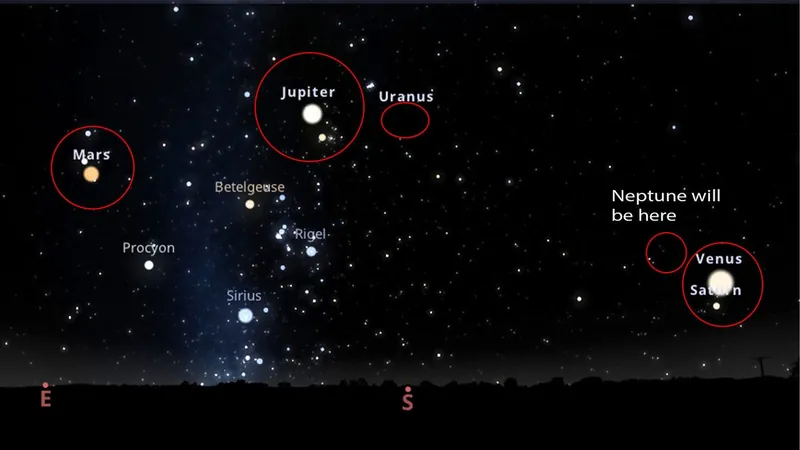
Don't Miss the Breathtaking Planet Parade: Six or Seven Celestial Bodies to Light Up Your Sky!
2025-01-19
Author: Wei Ling
Don't Miss the Breathtaking Planet Parade: Six or Seven Celestial Bodies to Light Up Your Sky!
Mark your calendars for January 21, 2025, because this date heralds an extraordinary spectacle for skywatchers: a dazzling planet parade! This unusual event occurs when multiple planets from our solar system align for a rare display in the night sky. This time, a spectacular array of six planets—Venus, Mars, Jupiter, Saturn, Neptune, and Uranus—will be visible, captivating astronomers and stargazers alike.
The planets will grace our skies not only on January 21 but also in the days leading up to it and for about four weeks following. While Mars, Venus, Jupiter, and Saturn are bright enough to be seen with the naked eye, spotting Neptune and Uranus will require a telescope due to their distant positions.
Best Viewing Times and Locations
The prime viewing window for those residing in the Northern Hemisphere will be just after sunset, around 8:30 p.m. local time. However, do keep in mind that by around 11:30 p.m. to midnight, Venus, Saturn, and Neptune may dip below the horizon depending on where you are. Meanwhile, Mars, Jupiter, and Uranus will shine longer, with Mars finally setting just before dawn.
One of the best aspects of this upcoming parade is its remarkable duration; unlike prior celestial events, the planets will remain in advantageous positions for nearly a month! Expect to enjoy this stellar sight until late February, when the planetary lineup shifts dramatically.
A Seven-Planet Expansion!
What’s more exciting? A week or so after the original six-planet parade, the event will expand to include Mercury, briefly bringing seven planets into view! This will provide a unique opportunity to witness a planetary gathering of all the known planets in our solar system—excluding Earth, of course. It’s important to plan your viewing as some of these planets will be increasingly difficult to see due to their proximity to the sun.
By early March, many of these planets will drift too close to the sun to be easily visible, leaving only Jupiter, Mars, and Uranus to light up the night sky until the next celestial display.
How to Prepare for the Dazzling Show
This planetary parade will be accessible across most regions in the U.S., Canada, and Mexico, so no matter where you are, you should have a chance to catch a glimpse of these majestic celestial neighbors. The optimal viewing window is set from late January until late February, with particularly great visibility during the week of January 29, coinciding with the new moon phase.
For the best experience, it’s advised to escape urban areas plagued by light pollution. Finding a dark spot away from city lights can significantly enhance your viewing pleasure. If you have access to a telescope, using one can offer a closer look at the distant planets, especially for Uranus and Neptune, which benefit from higher magnifications.
Spotting the Planets: Tips and Tricks
Given the challenge of locating Uranus and Neptune, as well as the close proximity of Venus and Saturn, utilizing stargazing tools can be beneficial. Apps like Star Walk 2, and platforms like Stellarium and Time and Date's Night Sky Map, offer indispensable guidance on where to find each planet in relation to the night sky.
What Exactly Is a Planetary Parade?
In colloquial terms, a planetary parade describes an event when multiple planets are visible in a line in the night sky. While the term is not officially recognized within the scientific community, NASA sometimes uses the phrase "parade of planets." The precise scientific term is "planetary alignment." However, in popular usage, both terms refer to the phenomenon where several planets can be spotted in the sky simultaneously—regardless of their actual positions in their orbits around the sun.
In summary, get ready for an unforgettable celestial experience this January and February! Mark the dates, grab your telescope, and prepare for a breathtaking view of our neighboring planets as they align in a stunning display across the night sky. Don't miss out on this rare opportunity to marvel at the wonders of our universe!





 Brasil (PT)
Brasil (PT)
 Canada (EN)
Canada (EN)
 Chile (ES)
Chile (ES)
 Česko (CS)
Česko (CS)
 대한민국 (KO)
대한민국 (KO)
 España (ES)
España (ES)
 France (FR)
France (FR)
 Hong Kong (EN)
Hong Kong (EN)
 Italia (IT)
Italia (IT)
 日本 (JA)
日本 (JA)
 Magyarország (HU)
Magyarország (HU)
 Norge (NO)
Norge (NO)
 Polska (PL)
Polska (PL)
 Schweiz (DE)
Schweiz (DE)
 Singapore (EN)
Singapore (EN)
 Sverige (SV)
Sverige (SV)
 Suomi (FI)
Suomi (FI)
 Türkiye (TR)
Türkiye (TR)
 الإمارات العربية المتحدة (AR)
الإمارات العربية المتحدة (AR)